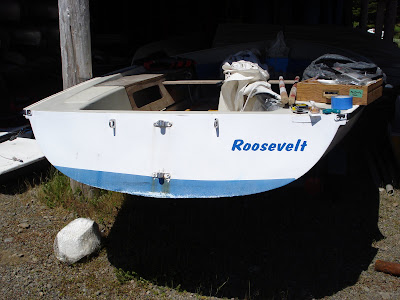So rather than being a good student and work on my two big graduate school papers this weekend, I of course went to Camp Parsons. It was, however, entirely worthwhile, because we were able to put the finishing touches on a lot of projects that we've been working on throughout the whole off season. It's looking like everything's going to be shipshape and Bristol fashion in time for the start of the summer season.
I'm not going to dwell too long on this, because I seriously do need to work on those papers, so I'll just share a short list and some pictures:
(1) The sailboats finally have names, thanks to the financial support of Mr Al Hutchison.


(2) The big float from Port Gamble finally has a deck. Ken bought about ten sheets of 3/4" marine-grade plywood, and Andy spent the whole morning and afternoon cutting them and nailing them all down, with only three inches of plywood to spare. I forgot to take a picture of the finished product, but it's pretty solid.
(3) The Ranger 20 finally got patched up. I've been waiting months for the weather to be dry and warm enough to apply the epoxy putty—it hit about 80 degrees this weekend and it was clear skies the whole time, so conditions were perfect. It's still going to take some sanding and painting, however, before we can put the Ranger 20 back in the water.
(4) We have brand new ten-foot reach poles.
So everything's going according to plan. I recall a certain Assistant Camp Director telling me that many people have promised him that all of his sailboats would be working, but none have ever actually done it. I should've put a wager on it.
Still haven't finished the pier sign though...
Here's one last picture of a bald eagle on Telescope Point. By my estimate, the area around Camp Parsons is home to about ten bald eagles. I've actually seen so many bald eagles this weekend and last weekend that I'm starting to feel somewhat blasé about them.
Okay, now off for some serious studying/paper-writing. No distractions for the next five days!














